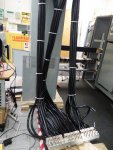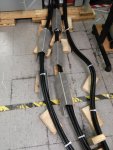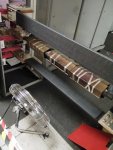gar:
From the pictures in post 25 and 26, the 'shorts' are wye connected. In post 25 you see three sets of wires (10x500MCM bundled by cable ties) going to a set of two hole lugs all bolted to a short, massive bit of bus bar. In post 26 you just see the wires, but not the short.
Sahib:
I think you are right about the steel acting as a shorted turn.
Girswald:
Even though the transformer secondary is shorted, there still has to be some (very small) voltage between the output terminals. This is necessary because the bus bars have to have _some_ resistance. This resistance means you have to have _some_ voltage drop, and some voltage that you can measure. The measurement would not be trivial; you would need to measure a small voltage with lots of magnetic field interfering with your measuring equipment...but the voltage will be there.
Could you post the dimensions of the bus bars?
As an example, a 1/2"x6" bus bar has a DC resistance of 2.74 _micro_ ohms per foot, is large enough that 'skin effect' will be an issue, and will also have an inductance that is significant at 3000A. Imagine a 3 phase bus assembly 100 feet long and shorted at the far end, with 3000A flowing on each phase. The phase to phase voltage at the supply end will be on the order of 1.5V. (Approximated using DC resistance only, real value should be higher.)
As a separate point: you describe the steel being used to 'choke' the current. The current in the wire induces a magnetic field in the steel, and that magnetic field induces a voltage that opposes the current flow in the wire. This 'choke effect' depends upon the magnetic properties of the steel.
As Sahib notes, current is also going to flow in the steel, heating it up. Not only will the heat change the resistance of the copper, but the heat will change the magnetic properties of the steel, and could cause damage to surrounding materials (it looks like some of the bus bar insulation has been melted away).
If you can, try to get steel 'chokes' made of transformer steel that is laminated into thin sheets. This sort of steel has high resistance, and the thin lamination material breaks up the induced current flow. I would suggest split cylinders made of stacks of 'washers' made from transformer steel laminations.
-Jon





